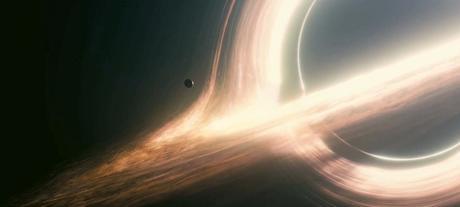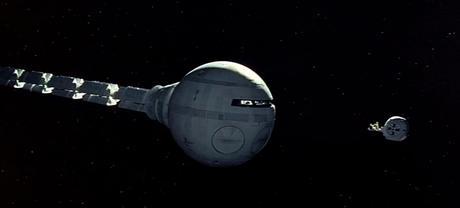CONTAINS SPOILERS. CRAZY BAT SHIT OF THEM!
You can tell I was super excited when I learnt that Christopher Nolan has picked up on the idea of black holes and wormholes in his next venture. Unfortunately, he made Inception earlier and ruined everything for me.While Inception was a huge leap in science fiction, it raised the bar for the kind of movies the duo of Christopher and Jonathan Nolan can achieve. Inception was worthy of all the hype it has ever got, because not only was it a brilliant movie, it was also a refreshingly cerebral idea. It was something new.With Inception having set the stage to welcome Interstellar to the movie theatre, it was the sense of expectation that undid everything. To list a few scientific inaccuracies (or shall we say) inconsistencies that I personally found with the movie, I would have to start somewhere here:
1. How did the wormhole - the one near Saturn - came to be in the first place? It takes an enormous mass to generate a gravity field sufficient to fold space-time in half, and the one in the movie being so large, it would have been equivalent to a couple hundred million times of our beloved sun. And that big a thing would certainly distort the gravitational orbital settings for the planets and asteroids and comets that are revolving around the sun. I believe they did link it up with Cooper's crash (depicted in the form of his nightmares) but surely a plane-crash isn't the best it would do, would it? And remember, it has been placed there by "them" and has been discovered quite a few years ago.2. We see large discs of gas around the black hole Gargantua, without there being an obvious source of all the gas and 'light'. But where does all this come from? English clergyman and philosopher John Michell, in a 1767 paper proposed the existence of double star systems where two stars optimally revolved around a common center of mass and in 1783, he published about something he called the 'Dark Stars' in the universe. That was the first depiction of black holes in science. Modern astronomers believe that black holes do indeed exist at the centers of most galaxies and as Michell proposed, that astronomers could detect these 'dark stars' by looking for star systems which behaved gravitationally like two stars, but where only one star could be seen.

Behold, Gargantua!
In a binary system (a term, first used by William Herschel, sometime in early nineteenth century) containing a black hole, gas from the other star can accrete onto black hole. This releases gravitational potential energy, causing the gas to become hotter and emit radiation. What we then see around Gargantua is some sort of visual depiction of the mass transfer between the black hole and it's (assumed erstwhile) cousin, the sun. Maybe also, we see some parts of the accretion disk.P.S. Most of the black hole aficionados of our time know about the bet between Kip Thorne (executive producer and advisory for Interstellar) and Stephen Hawking (needs no introduction) regarding the existence of a black hole in the best known example of an X-ray binary solar system - the Cygnus X-1. In Cygnus X-1, the mass of the unseen companion is believed to be about nine times that of our sun, and is therefore believed to be a black hole. Read up, one promised the other decade-long subscriptions of Private Eye while the latter promised the former a decade-long subscription of Penthouse. Don't you love Physicists?Not to digress a lot from the topic any further, there were no other star in that system. It was a singular solar system, with Gargantua being the (w)hole and soul of the system. Also, and I'll be rather willing to let live this liberty, they never explained how the spaceship and the astronauts survive the tremendously high energy X-Rays near the black hole. Maybe they were resistant, who knows?!UPDATE: Someone pointed out that it is not a binary system and that the black hole has formed as the original star has died. and to that I say that statistically, it is not so probable for a star that huge to form a black hole. A dwarf or a neutron star maybe, but not a black hole. Either way, I think I am rather nitpicking now. 3. To maintain the level of time dilation explained in the movie - the 1 hour in this universe equals 7 years on Earth - the planet would have to be really close to the black hole. And again, if you're so close to the black hole, you cannot maintain a stable orbit! However, for the sake of story progression, I'm willing to let go of this assumption. 4. Now here is a big issue that I've raised regarding the movie. Partly because I knew this was coming and just wanted to see how it's being addressed in the movie, visually: How is the physical complexity of Cooper's spacesuit and body maintained as he passes across the event horizon and towards the black hole's singularity? It would've been broken down into some sort of an energy form or at least it could've been "dilated" or "stretched" (not being too faithful to the word!). I wanted to see how they show it and I was almost expecting a big booming voice from the sky as well. 5. How can anyone transcend across dimensions and successfully alter the physical state of matter (such as the books)? I can totally understand how he manipulated a force field to transmit a signal across, but physically throwing a tantrum in there and expecting the person to perceive it across different timelines is impossible. No, no arguments there - it's plain impossible. If you're going to say 'Love is the one thing that transcends space and time' I'm going to crumple it into a singularity as they say and shove it up your... yes. 6. A singularity within a black hole is a mathematical assumption, I believe. But does it still hold true if one assumes that a black hole is but a portal for a wormhole? I mean, you never really encounter the singularity then, do you? As soon as you step in from one side into the 'spherical' black hole, you step out from the other side.. in a twisted Schrodinger-esque logic, you are both in the black hole and you're not! 7. And lastly but not least, what happens when you cause an explosion in an ammonia rich atmosphere? Does the explosion behave any differently? Food for thought! Having said all that, I would say that Interstellar is a great science fiction movie that brings out a lot of existential and philosophical questions regarding time travel and interstellar exploration. But I would've had a little more expectation from Christopher Nolan. He thought it right - mostly - but he totally failed to 'show it right'. And it is a sad sad day, as I never expected anyone to be able to say those words about the great director. Let alone myself. As a movie, devoid of all the science, I believe Nolan didn't do a fine job in developing the father-daughter relationship through his story. He did as much as what Zack Snyder did in Man of Steel (2013), as he killed off Superman's foster father right in front of him while he must've breathed a sigh of relief ("One less Academy nominated actor to deal with!"). Nolan rode on the credibility of the actors and hoped for it to ascertain the relationship, but it would've done more justice had it been depicted through the story's timeline.In Inception, the story revolved precariously around the relationship between Cobb and Mal. Nolan spend ample time in developing their relationship and with Ariadne trying to dig deeper into Cobb's consciousness and with Arthur revealing it slowly to her, they build up the backstory pretty convincingly. However, in Interstellar, the relationship between the young Dr. Brand, super military computer TARS and Cooper was rather better developed than that of the father and daughter. While it should've been the other way around as the latter was but rather the focus of the movie.Arguably, there were just two scenes that convincingly showed that Cooper was close to his kids. One, where he looks for Murph hiding on the shotgun seat, half-hoping that she is there as he leaves for the journey forever. And two, when he cries along with the initially more devoted son Tom, as the latter sends him video messages light years across the solar system to tell him that his granddaughter (whom Coop never could meet) passed away. But the seeing-off of the father and his kids, lacked so much credibility that it totally killed the effect that those previous scenes had built.
"Open the pod bay doors Hal" AAAAAAAAAAAHH!
I would still keep 2001: A Space Odyssey way higher in terms of a space-time adventure. It came out in 1968 and still managed to show a better space. Tell me you didn't love the piece of waltz by Johann Strauss 'The Blue Danube' during a far more visually appealing 'docking' procedure? The existential, philosophical, religious and allegorical interpretations in that movie were far greater than what Interstellar could provide in it's comparable running time of almost 3 hours.I'm glad though that mankind in Christopher Nolan's world has learnt to make advanced robots that have the most amazing sense of humor and are not as objectively twisted as the HAL 9000. "Open the pod bay doors, Hal" gives me the creeps even now.Also, if you liked the second half of Interstellar, I recommend you go and watch Danny Boyle's uncannily similar science fiction thriller named Sunshine (2007). You will be surprised how much this movie by Nolan has knowingly or unknowingly drawn from it.UPDATE: I've read and reread this post quite a few times. Mostly, I was looking for reasons to deny my own verdict. And I think I finally found one: I watched this movie from a preconceived understanding of how cerebral Inception was. In order to avoid the confusion we all faced while watching that, this time I decided to pay attention to the science behind Interstellar. But then unlike Inception which was more psychological, this was rather more physics - albeit fiction - but that's more well documented and established than psychology.Interstellar (2014) is more of an emotional drama than science fiction. This is something I realized much later while exclusively listening to the soundtrack. Listen to tracks 'Day One', 'Stay', 'Coward', 'Detach' and 'Where We're Going' from the OST and you'll know. They are fueled with emotion, rather than action. Very much unlike Zimmer's Angels and Demons, Man of Steel and Inception, which were rather high octane on action (I mean what else do you call the tracks Mombasa and Dream is Collapsing from Inception?!). The science fiction part was more of a collateral in the case of Interstellar. It was always supposed to be an emotional drama about what interstellar travel can do to interpersonal relationships and the toll it takes on the human psyche.It's really quite a brilliant idea, in that case. I think I like the movie more now. Not as a science fiction, but as an emotional drama with science as the collateral.In support, is Astrobiologist David Grinspoon. He won the 2006 Carl Sagan Medal. He also advises NASA on planetary exploration and is involved with the Venus Express spacecraft and the Curiosity Rover on Mars. Listen to his interview down below, or read the transcript of the MotherJones interview by clicking here.